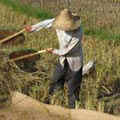|
作者:萊思特•R•布朗
如果中國的農業問題並沒有嚇到你,那麼於今年(2001)夏天發表的一篇報告;雖然當時並未引起太多注意,但其中陳述著這個國家的供水問題現況,就應該足以讓你覺得「口乾舌躁」。這份報告指出,「乾涸」就是主要的問題所在。中國的華北平原供應了全中國超過一半的小麥及三分之一玉米的數量,然而,為了灌溉而大量抽取地下水,導致地下水位正以驚人的速度下降中。
這份報告由北京地質環境觀測研究所製作,其中指出,超抽地下水已使得地表的地下蓄水層乾枯,也迫使掘井者開挖此地區更深的地下蓄水層。這是個壞消息,因為深一層的地下蓄水層是無法自行補充的。位於中國華北平原心臟地帶的河北省,其深層地下蓄水層的平均水位,在去年幾乎下降了10英呎,在其中一些城市的區域裡甚至超過20英呎。

工作中的中國農夫(照片提供:ArtToday)
北京地質環境觀測研究所地下水觀測隊的領導人,何青城(音譯)表示:隨著華北平原的深層地下蓄水層逐漸消耗,這地區最後的水源保留地層將會漸漸消失,也破壞了地下水安全網。
他的憂慮也反映在世界銀行的報告中。根據所觀察的證據顯示,為了取得淡水水源,北京附近的深井目前已達到1,000公尺之深,使得供水的成本大幅提高。即使平常發言傾向保守的世界銀行,也以極強烈的語氣指出,這份報告預測,除非水的供需能盡速恢復平衡,否則「災難將會禍延子孫」。
乾枯的河流
最近幾年的掘井熱,是進一步呈現華北平原水資源事態嚴重的證據。在1996年底,這片平原上的五個主要省份-河北、河南、山東及(規模似省的)北京市、天津市中,擁有360萬口井,絕大部分用以灌溉。隔年,有99,900口井因乾枯而遭廢棄,並另外開挖221,900口新井。在中國,這樣瘋狂尋找水源的行為一直持續至今,這些掘井者等於是跟著地下水位下降的方向跑。(編按:中國的行政劃分與台灣不同,例如北京市,人口約1,200多萬,可分為四區,共10個區和8個縣。)
最後的結果顯而易見:中國的北半部地區漸漸都乾枯。過度的用水需求,使得向東流入華北平原的三條河-黑河、黃河及淮河,在整個旱季都是乾枯的,有時甚至在非旱季也是如此。中國糧食生產重鎮-山東省,是黃河流經的8個省中的最後一個;黃河注入山東地區的水量,自1980年代早期的400億噸,降到1990年代的250億噸。

中國華北平原(地圖提供 美國國務院)
隨著地下水位下降,泉水跟著乾枯、溪流消逝、河水枯竭、湖泊也不見了。河北省一度擁有1,052個湖,目前只剩下83個。
華北平原的水資源供給,每年有400億噸的短缺(也就是供水量低於用水量)。目前,這短缺的部分,便是由開採地下水來填補。一旦地下蓄水層消耗殆盡,這裡就再也沒有什麼水資源了,而此流域的供水量將會短少40%。在淮河流域,像北京、天津這樣的城市及工業用水,是優先被供應的。到2010年前,灌溉農業將會大量消失,而回歸到倚靠雨水且產量較小的農業型態。
根據預估,從現在到2010年之間,中國人口會增加1億2千6百萬。世界銀行預計整個國家的城市用水需求將從500億噸躍升至800億噸,約成長60%;同時,工業用水量將增加62%,從1,270億噸增至2,060億噸。

像這樣的灌溉用水方法,它的水源正逐漸乾涸消失。(照片提供 ArtToday)
工業用水的價值是農業用水的70倍,因此在這稀有資源的爭奪戰中,農夫總是輸家。隨著地下水位持續下降,抽取地下水成本的升高,這會使得許多農夫因利用地下水的成本太高而無法取水灌溉。(2001.10.26)
【文章連載】
■中國地下水位的酷刑 (上) (下)
全文與圖片詳見: http://www.gristmagazine.com/grist/main
dish/brown102601.asp
版權歸屬Earth Day Network,環境資訊協會(鄧國光 譯,黃媺雯 審校)
中英對照全文:http://e-info.org.tw/issue/water/2002/
wa02011401.htm
|
|
by Lester R. Brown
If you aren't normally fascinated by China's agricultural problems, then an obscure report issued this summer on the state of the nation's water supply might have struck you as rather dry. But in this case, dry is precisely the problem: The water table under the North China Plain, which produces over half of China's wheat and a third of its corn, is falling at an alarming rate.
The study, conducted by Beijing's Geological Environmental Monitoring Institute (GEMI), reported that over-pumping has largely depleted the shallow aquifer, forcing well-drillers to resort to the region's deep aquifer. That's bad news, because the deep aquifer cannot be replenished. Under Heibei Province in the heart of the North China Plain, the average level of the deep aquifer dropped by almost 10 feet last year. Around some cities in the province, it fell by more than twice that.

A Chinese farmer at work.Photo: ArtToday.
He Qingcheng, head of the GEMI groundwater monitoring team, says that with the depletion of the deep aquifer under the North China Plain, the region is losing its last water reserve -- drain that, and the safety net is gone.
His concerns are mirrored in a new World Bank report: "Anecdotal evidence suggests that deep wells [drilled] around Beijing now have to reach 1,000 meters [more than half a mile] to tap fresh water, adding dramatically to the cost of supply." In unusually strong language for the normally restrained World Bank, the report forecasts "catastrophic consequences for future generations" unless water use and supply can be brought back into balance soon.
Dry Me a River
The frenzy of well-digging in recent years provides further evidence of the gravity of the water situation in the North China Plain. At the end of 1996, the five provinces of the North China Plain -- Heibei, Henan, Shandong, and the city provinces of Beijing and Tianjin -- had 3.6 million wells, the bulk of them for irrigation. The following year, 99,900 wells were abandoned as they ran dry. Some 221,900 new wells were drilled. The desperate quest for water in China continues today, as well-drillers chase the water table downward.
The bottom line is simple: The northern half of China is drying out. Excessive demands on the three rivers that flow eastward into the North China Plain -- the Hai, the Yellow, and the Huai -- are causing them to run out of water entirely during the dry season, sometimes for extended periods of time. The flow of the Yellow River into Shandong Province (the last of the eight provinces it passes through en route to the sea, and China's leading grain-producing province) has dropped from 40 billion tons a year in the early 1980s to 25 billion tons during the 1990s.

The North China Plain. Map: U.S. State Department.
As water tables fall, springs dry up, streams cease to flow, rivers run dry, and lakes disappear. Hebei Province once had 1,052 lakes. Only 83 remain.
The water deficit in the North China Plain (that is, the amount by which use exceeds sustainable supply) may now exceed 40 billion tons per year. At present that deficit is being filled by groundwater mining, but when aquifers are depleted and there is nothing more to mine, the basin's water supply will be cut by nearly 40 percent. In the Hai River Basin, where industry and cities like Beijing and Tianjin now get priority for water use, irrigated agriculture could largely disappear by 2010, forcing a shift back to less productive rain-fed agriculture.
Between now and 2010, when China's population is projected to grow by 126 million people, the World Bank predicts that the country's urban water demand will jump from 50 billion to 80 billion tons, an increase of 60 percent. Industrial water demand, meanwhile, will increase 62 percent, from 127 billion to 206 billion tons.

Irrigation projects like this are drying up. Photo:
ArtToday.
With water worth easily 70 times as much in industry as in agriculture, farmers almost always lose out to cities in the competition for an ever-scarcer resource. As water tables continue to fall, rising pumping costs will make underground water too costly for many farmers to use for irrigation. (2001.10.26)
http://www.gristmagazine.com/grist/main
dish/brown102601.asp
|
